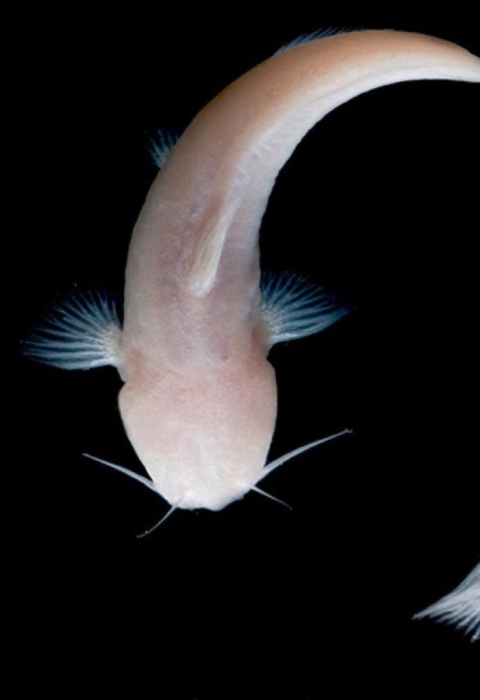Texas is home to the only three species of troglobitic, or cave-dwelling, catfish in the United States: the widemouth blindcat (Satan eurystomus), the toothless blindcat (Trogloglanis pattersoni), and the Mexican blindcat (Prietella phreatophila).
In the absence of light, underground cave-dwelling species develop unique, dare we say “weird looking” adaptations to survive. But don’t judge them too harshly — beauty serves no purpose for creatures that live in total darkness.
One of their most notable adaptations is the lack of eyes. Since they swim around in the dark, they instead find food using taste, smell, heat, flow, and touch.
Since they are not exposed to sunlight, they also don’t need pigment to help protect their skin from ultraviolet radiation. This is why they look pink and slightly translucent.
And unlike their surface relatives, Texas’ blindcats don’t have an air bladder to help them maintain their depth in the water. Instead, they have generous accumulations of fat in the area where the air bladder would occur.
Keep reading to find out more about each of these bizarre (yet oddly charming) species.
Widemouth Blindcat
More than 1,000 feet below the city of San Antonio is one of the most diverse subterranean aquatic ecosystems in the world: the Edwards Aquifer. Within the aquifer, there is a zone where freshwater and saline water meet, called the “bad water zone.” This is where you’d find the widemouth blindcat, commonly called Satan.
In this habitat, Satan is the top carnivore. Described by researchers as an “opportunistic predator that feeds on any organism that it can get into its wide mouth,” Satan obtains its crustacean-heavy diet by a highly developed acoustic system and large barbels.
Despite its tough-guy name and top place on the food chain, Satan is actually pretty small, ranging from about 1 to 4.5 inches long.
This species was first described in 1938, when one of the strange catfish was drawn up from a well and donated to a museum in San Antonio. In the years that followed, more of these fish were found when artesian wells pulled them up from the deep. The last known specimens were collected by Texas State University researchers in 1978. At the time, the researchers optimistically said, “If we were able to collect from all the wells in the area assumed to contain fish, the numbers would be overwhelming.”
Unfortunately, the species has never been found again. But it’s not for lack of trying — environmental consulting firm Zara Environmental LLC, the University of Texas at Austin, and the U.S. Fish and Wildlife Service are currently monitoring artesian wells in Bexar County for specimens of this species and its DNA.
Since we’ve seen so few, they live in such a specific habitat, and there have been threats to the Edwards aquifer, we’re currently reviewing this species for a possible Endangered Species Act listing.
Toothless Blindcat
In the “bad water zone” of the Edwards Aquifer, you can also find the toothless blindcat. Unlike its predatory cousin, Satan, this species has no teeth. Instead of finding cave-dwelling crustaceans to munch on, it feeds off of the bacterial mats that are associated with the bad water zone’s increase in salinity and temperature.
This species is also quite small, ranging from a little more than 00.5 to 3.5 inches long.
The toothless blindcat is thought to be more abundant than the widemouth blindcat — or at least more of them have been found through sampling efforts over the years.
Since they were first described in 1919, the fish has periodically washed up in artesian wells into ditches and other drainage sites. In 1978, Texas State University researchers collected 26 specimens of the toothless blindcat, and they weren’t found again until 2013 when Zara Environmental LLC found 14 specimens of the fish from three wells.
In 2020, U.S. Fish and Wildlife Service biologists found evidence that the species continues to survive in the Edwards Aquifer after collecting its tissue and bones in nets placed in an artesian well’s discharge pipe.
The search for the toothless blindcat continues, with multiple organizations continuing to monitor artesian wells in Bexar County for specimens of this species and its DNA.
For the same reasons as Satan, we’re also reviewing this species for a possible Endangered Species Act listing.
Mexican Blindcat
In 2016, a third species of troglobitic catfish was discovered in Texas when a National Park Service employee spotted a Mexican blindcat in a deep limestone cave at Amistad National Recreation Area near Del Rio. Though the species had been known to exist in Mexico since 1954, this was the first time it had ever been spotted in the United States.
The Mexican blindcat only gets up to 3 inches long and is found in the Edwards-Trinity Aquifer below the Rio Grande basin in Texas and Mexico.
It is currently listed as an endangered species by the Mexican government and the U.S. Fish and Wildlife Service.
Of the three troglobitic catfish in Texas, this is the only species that is currently held alive in captivity. The San Antonio Zoo’s Department of Conservation and Research currently holds a pair of the catfish in a special facility designed for cave species.






